Autocar Magazine - Road Test- 24 May 2000 issue
Introduction
IT
SEEMED an impossible brief. When
the green light was given for the wildest Lotus road car ever, the Hethel
crew knew they would have to beat a benchmark they themselves had created.
The new 340R needed to be even more focused, even sharper and even
more elemental than the terrifically conceived Elise.
The new car would face the task
of taking the Lotus guiding principles of innovation, lightweight
construction and a purity of driving experience to new levels.
And it would need plenty of road presence to make sense of its £35,000
price. In short, the 340R
would need to look more than a little special.
Few
would disagree that the 340R packs a visual punch of supercar strength. In fact, public reaction to the show car which made its
Birmingham debut in '98 - played a key role in convincing a cautious Lotus
to go ahead with the project.
Designed
by Russell Carr, the 340R is absolutely faithful to the Lotus tradition.
Beautifully sculpted but minimal bodywork allows this new Lotus to
expose visually intriguing details of suspension, engine and exhaust.
All of this mechanical jewellery helps give the 340R a feeling of
designed-in value, and goes some way to justifying that steep price.
But
the ultimate test of any new Lotus has always come on the road.
Stunning as it is to behold, the 340R must deliver a driving
experience considerably more rewarding than that of its much less
expensive sibling. An that is
the toughest brief of all.
Design
& Engineering
Inspired
by motorcycle and single-seat racer designs, the 340R aims to maximise the
driving experience by minimising excess.
So there are no doors, no sidescreens, no luggage compartments, no
radi or creature comforts of any description.
It's a category defying configuration that has sent the DVLA into a
spin; it classes the 340R as an MPV.
Many
340Rs will see some track use, where the adjustable platform suspension
will allow fine tuning of corner weights.
Like
the Elise, it is made from extruded and bonded aluminium, with the chassis
serving as the load-bearing structure.
As the body panels don't need to help with structural integrity,
they are very light and used very sparingly.
Composites are used for the body structure, and .aluminium abounds
throughout But the 340R - so named for it intended power-to-weight ratio
of 340bhp per tonne - hasn't quite lived up to its moniker.
The target was 500kg, but it weighs 675kg.
Even so, 262bhp per tonne is still impressive.
That
power comes from a
heavily modified version of the 1796cc Rover K-series four.
Here it makes 177bhp at 7800rpm and 1261b ft of torque at 5000rpm.
To get the most out of it, there's a tightly stacked gearbox with
finely judged ratios. And to
make sure the sound matches the styling, an extra inlet valve opens under
heavy load to enhance the induction noise, while still allowing the car to
pass noise tests under regular loads.
For
even sharper responses than the Elise, the 340R has specially developed
Yokohama tyres. Their very
sticky soft compound promises huge grip in the dry, if slightly less
ability in the wet.
Lotus
has specified seriously capable brakes; the 282mm (front) and 245 mm
(rear) discs are cross-drilled and use AP Racing opposed-piston calipers.
While the 340R shares most of its suspension components with the Elise, the settings are much more aggressive, with lower and stiffer springs and uprated dampers. As with the rest of the car, driving experience is the only thing that matters.
Uncompromising design, beautifully rendered detail - 4 stars
Performance
& Brakes
Because
the 340R missed its power-to-weight target of 340bhp per tonne, the paper
statistics are less impressive than we had hoped; 0-60mph takes 4.6see,
with 100mph arriving in 12.5see. Those numbers are shaded by the current
king-of-the-hill
Further,
it is the quality of its performance that marks the 340R; this must be one
of the most rev-happy versions of the K-series ever produced.
From as little as 2500rpm the 177bhp engine picks up cleanly, tacho
swinging in a fast are to the 7800rpm cut-out.
The exhaust note evolves from a low growl to a serrated-edge
scream, unencumbered by engine bay insulation.
It's a wonderful noise, and is accompanied by as much thrust as
anyone could sanely ask for Working through the gears, you won't encounter
a big ratio gap; the 340R accelerates relentlessly to its 132mph top
speed. Significantly, second
gear is good for 75mph, which gives real B-road firepower. The
cable-operated gearbox, though, is a little vague and notchy to use,
especially when hurried along. Shorter
throws and a more precise action would be welcome.
The
Lotus is hugely reassuring in passing and merging manoeuvres.
Held in second, the 340R gets from 30 to 70mph in just 4.2see. And
the 50-70mph dash takes just 2.4see, which gives the Lotus a very large
margin of safety for slicing past slower traffic.
The
340R has the stoppers it deserves, the all round ventilated and
cross-drilled disc brakes showing no sign of fade, even
after repeated hard stops from 100mph.
Brake feel is excellent. There's
no power assist and no anti-lock. Those
Yokohamas inspire supreme confidence in the dry but aren't so good in the
wet.
Fine performance and first-rate brakes - 4 stars
Handling
& Ride
The
340R needed to feel very different to the Elise.
It does.
The
architecture might be similar - independent upper and lower wishbones all
around, co-axial springs and adjustable Konis - but the on-the-road
results are a revelation. The
340R uses a spring and damper set-up that Lotus deploys on the hard-man
Sport 190 Elise. That brings lower and stiffer springs, as well as uprated
dampers. Rounding out the
package are those sticky A038 LTS tyres.
Put
the 340R through a favourite medium-fast corner at ever increasing
velocity and marvel at the fantastic grip.
When you expect the nose to run wide or the tail to step out under
power, the 340R just continues about its business, holding resolutely onto
the selected line. It sounds
clinical but isn't - superbly weighted steering feeds back the minutest
details of grip and surface, and the suspension does an amazing job of
smoothing away midcorner thumps and bumps.
Even
over rough B-roads,
That
the 340R is massively good to drive is beyond dispute.
Which makes the ride even more remarkable.
With stiffer springs and uprated dampers, you might expect to
suffer over rougher roads. Not
so; it deals nicely with dips and ridges.
And over roads with constant little niggles of surface and camber
change, you can actually watch the rear wheels coping.
Line either one up in the mirrors and you'll be amazed at the
amount of work the suspension is doing as the wheels adjust to keep the
car smooth and level.
The 340R feels much more responsive than the Elise on the road, with an ability to change direction that borders on the psycho-kinetic. That it can manage that without spoiling the ride quality is a typically impressive Lotus achievement.
Another
Lotus star gets the
balance right
- 5 stars
Comfort,
Safety & Equipment
The
absence of side windows, roof or any creature comforts that might add
weight and rob power doesn't at first seem like such a bad trade.
The super supportive seats are actually quite comfortable and the
driving position is spot on. It also feels quite special from behind the wheel, with that
central aluminium tower housing lighting and screen demist controls.
The whole environment feels like cutting edge British architecture;
even the handbrake is a beautiful piece of industrial design.
At night, the instruments glow a cool neon blue.
In
less than ideal conditions, though, the 340R can be quite punishing.
On a hot day, the heat from the front-mounted radiator is absorbed
into the aluminium structure around the front of the cockpit, roasting the
occupants. And the lack of
wet weather gear will inevitably cause frustration, even with the best
laid plans.
There
is no storage for luggage of any kind.
With two on board, there isn't even room to bring along the basic
tonneau that protects the car's interior from weather.
Which is a shame, because this is a car that you'll want to drive a
very long way.
As
you might expect, the 340R's equipment list is short, and closely related
to its mission. Competition-style
seats are standard, as are four-point competition harnesses.
Inside, the car benefits from a heated front screen, a Stack
digital read-out and a wonderful-to-hold three-spoke leather trimmed
steering wheel.
Options
available on the 340R include the Track Pack, which gets the car ready for
serious track use. It
features an engine upgrade to 190bhp, an oil cooler, alloy six-gallon fuel
tank and a carbon fibre track seat.
Safety
on the 340R is largely derived from the immense strength of the structure,
as well as its remarkable ability to stop
and change direction; there are no airbags and no anti-lock brake system.
Perhaps
a little too uncompromising
- 2 stars
Market
& Finance
Given
that the run of 340 340Rs has already sold out, it's plain there is more
demand than there are cars. And
Lotus is adamant that no more than 340 will be built.
While you would expect, 340R coming to market now to demand a big
premium, HR Owen recently offered one for the list price.
That's refreshing but with so few 340Rs around, don't count on such
generosity from current owners. Long
term residuals should be excellent.
Insuring
what is effectively a race car for the road won't be easy or cheap; most
insurers classify the 340R in the highest bracket.
Proven and relatively simple mechanicals should mean servicing is reasonably priced.
Likely to hold value very well over the long term - 5 stars
Economy
The
formula here is pretty simple - push a 340R very, very hard and fuel
consumption will drop into the teens.
That's
at near race track velocity, though, and during regular road use you'd
struggle hard to get below 20mpg.
With
a realistic mix of motorway use and B-road
thrashing, we recorded a quite reasonable test average of 26mpg.
Gratifyingly, take it a bit easy and fuel economy soars into the
30s.
The fuel tank holds a reasonable 8.8 gallons, which should deliver a range of well over 200 miles, even with a bit of press-on driving.
Supercar performance with hot hatch thirst - 5 stars
The Autocar Verdict
The
340R exemplifies everything that has made Lotus great, on the track and
off. Adhering strictly to the
guiding principles of lightness, innovation and an undiluted driving
experience, Lotus has created a car that, astonishingly, is better to
drive than the Elise. It is
beautifully executed, striking a balance between gorgeous technical detail
and architecturally inspired sweeps of aluminium and composite.
The
340R has all the performance any enthusiast could ask for, delivered with
a soulful exhaust note. Its
handling displays a just about unrivalled sharpness of response and
intimacy of feedback. Yet it
delivers ride quality that would be tolerable on an intercontinental
blast.
That
said, the absence of storage space would make a long trip impractical. And it can get unbearably hot in the cockpit.
At £35,000 the 34R is, frankly, a very expensive exercise in
minimalism.
All
true. And after one memorable
drive, perhaps, all forgivable.
Purest Lotus yet nudges perfection - 5 stars
Copyright
Autocar magazine May 2000
Tester's Notes:
Highly
tuned K-series engine didn't care for idling in traffic, and developed a
misfire at 5000rpm, which disappeared as mysteriously as it arrived.
Happiest on super unleaded.
Interior
is quite comfortable for two, but the lack of grab handles for passenger
meant some frantic groping at the sills as cornering speeds rose.
Difficult, as the passenger's tap is what constitutes luggage space.
Aluminium
gear knob Is pretty - and easy for souvenir hunters to unscrew.
One tester got into the habit of taking it with him whenever he
left the car unattended without the tonneau on.
Very
positive reaction from the public Everyone wants to know what it Is, but
seems surprised to see a Lotus badge on such a radical design.
One observer even asked if it was the new TVR.
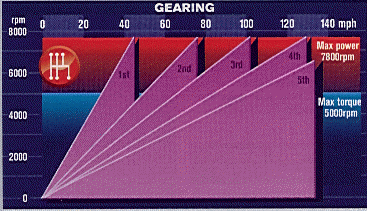
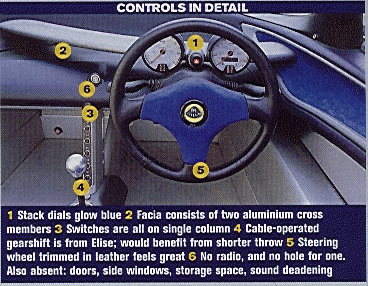
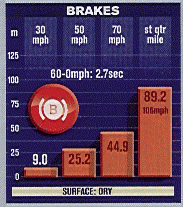
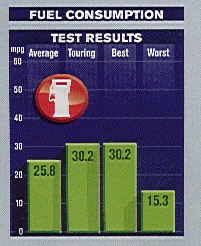
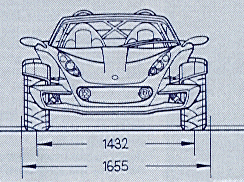
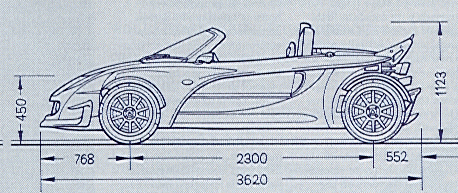
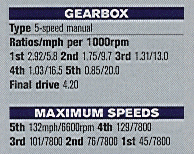
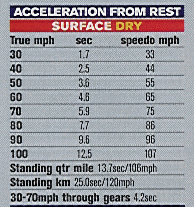
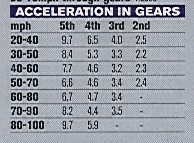
To support this site please click on our sponsors link below :
Mitsubishi Air Conditioning - by Celsius Air Conditioning Ltd